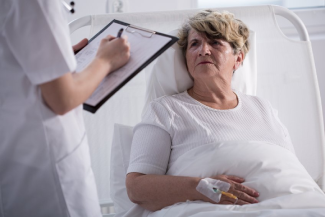Legal Perils and Pitfalls of Wound Care: Nutrition Assessment, Support, and Documentation, Part 3
September 24, 2020
Part 3 in a 3-part series looking at nutritional assessments and avoiding nutrition related litigation. Read Part 1 Here and Part 2 Here. "Defendants failed to provide adequate nutrition to prevent plaintiff from suffering severe malnutrition and weight loss. This allowed the development of a severe pressure ulcer, numerous infections, and dehydration and malnutrition. Had defendants provided proper care, the pressure ulcer, infections, and malnutrition and dehydration would not have occurred."
Before discussing the next few nutritional recommendations of the 2019 National Pressure Injury Advisory Panel's (NPIAP) Pressure Injury Guidelines, let's define adult malnutrition. The Academy of Nutrition and Dietetics/American Society for Parenteral and Enteral Nutrition (ASPEN)1 defines it as the presence of two or more of the following characteristics:
- Insufficient energy intake
- Unintended weight loss
- Loss of muscle mass
- Loss of subcutaneous fat
- Localized or generalized fluid accumulation
- Decreased functional status
The NPIAP states that malnutrition does indeed impact pressure injury (PI) development and healing.2 It invariably is a part of most, if not all, PI-related lawsuits. In the previous two blogs, I discussed the 2019 NPIAP guideline recommendations #1 through #9; let's focus on Guideline #10, which deals with supplementation.
Is There an Association Between Vitamin D and Wound Healing?
NPIAP Guideline #10: Supplementation
"Provide high calorie, high protein, arginine, zinc and antioxidant oral nutritional supplements or enteral formula for adults with a Stage 2 or greater PI who are malnourished or at risk of malnutrition." This is a change from the 2014 guidelines, which recommended supplementation starting with stage 3 or greater PIs. We have more evidence that shows that the sooner you put a good nutrition regimen into place, including arginine and micronutrients, the better.3-5 When looking at cases to determine whether the facility met the standards of care, I do look for what supplementation was offered, preferably recommended by a registered dietitian. Many algorithms and policies dictate the addition of supplements for those who are at risk as well as those with skin breakdown, and the NPIAP guidelines confirm this.
What Supplements?
Calories
First, it is important to underscore that energy needs (i.e., calories) must be met first to spare protein from being used as an energy source and before protein supplements can possibly be expected to produce results. There is nothing miraculous about supplements that will prevent or undo the use of muscle tissue for energy because of a lack of calories leading to protein-energy malnutrition. Wound healing is stalled if there is insufficient energy to maintain lean body mass.
Protein
Research supports the theory that increased protein levels are linked to PI healing, and additional protein, such as suggested in Guidelines #5 through #8, should be offered. Lean body mass is maintained when an older adult consumes higher levels of protein, in the range of 1.0 to 1.2 g/kg per day.6
Arginine
Arginine is a conditionally indispensable amino acid, meaning that it must be exogenously supplied when an individual is under stress. This describes just about all of our PI patients, doesn't it? Studies show that arginine plays a role in collagen synthesis, is vasodilatory, is angiogenic, and is needed to promote cell division, immune function, and hormone release. It stimulates T-cell responsiveness, helping to prevent infection.
Zinc
Zinc is a cofactor for collagen formation and metabolizes protein as well as assists in immune function. The usual dietary reference intake is around 11mg of elemental zinc per day. The usual dose we give to patients is 220mg of zinc sulfate, which equates to 50mg of elemental zinc. We need to be careful with zinc supplementation, however, because megadoses of zinc may actually cause a copper deficiency and may inhibit healing. Before giving megadoses, the recommendation is to determine whether a zinc deficiency is actually present, and then dose accordingly.
Antioxidants and Micronutrients
Micronutrients, including vitamins C, E, and A, play a role in PI healing and are key components of a healthy diet. Look for these nutrients in the supplements you are offering because they are essential and will help in wound healing; however, bear in mind that there is no evidence to support macrodoses of micronutrients. So, the "old" 500mg vitamin C once or twice daily order for short-term use may be beneficial, but overall it may have limited value in wound healing.
But Beware…
Adequate nutrition and the use of supplements are necessary components of maintaining health and promoting wound healing, but they should be undertaken based on evidence and research. Sometimes, in looking at charts, the facility appears to be "throwing" supplements and vitamins at patients, almost exposing a desperation when wounds are not responding to current treatment. Be sure you are not guilty of this and in the process are potentially overlooking other necessary interventions or causes. Next Up Continue with the NPIAP guidelines!
References
- White J. Consensus statement: Academy of Nutrition and Dietetics and American Society for Parenteral and Enteral Nutrition: characteristics recommended for the identification and documentation of adult malnutrition. JPEN J Parenter Enteral Nutr. 2012;36(3):275-283.
- National Pressure Injury Advisory Panel. Prevention and treatment of pressure ulcers/injuries: clinical practice guideline. 2019. www.npiap.com. Accessed August 20, 2020.
- Cereda E, Klersy C, Serioli M, Crespi A, D'Andrea F; OligoElement Sore Trial Study Group. A nutritional formula enriched with arginine, zinc, and antioxidants for the healing of pressure ulcers: a randomized trial. Ann Intern Med. 2015;162(3):167-174.
- Van Anholt RD, Sobotka L, Meijer EP, et al. Specific nutritional support accelerates pressure ulcer healing and reduces wound intensity in non-malnourished patients. Nutrition. 2010;26(9):867-872.
- Trans Tasman Dietetic Wound Care Group. Evidence based practice guidelines for the dietetic management of adults with pressure injuries. aci.health.nsw.gov/au. Accessed August 20, 2020.
- Vikstedt T, Suominen MH, Joki A, Muurinen S, Soini H, Pitkälä KH. Nutritional status, energy, protein, and micronutrient intake of older service house residents. J Am Med Dir Assoc. 2011;12(6):302-307.
About the Author
Heidi H. Cross, MSN, RN, FNP-BC, CWON, is a certified Wound and Ostomy Nurse in Syracuse, NY. She has extensive experience caring for wound and ostomy patients in acute care as well as in long term care facilities. Currently, she is employed by CNY Surgical Physicians consulting for nursing homes in the Syracuse area, and has served as an expert witness for plaintiff and defense attorneys.
The views and opinions expressed in this content are solely those of the contributor, and do not represent the views of WoundSource, HMP Global, its affiliates, or subsidiary companies.











